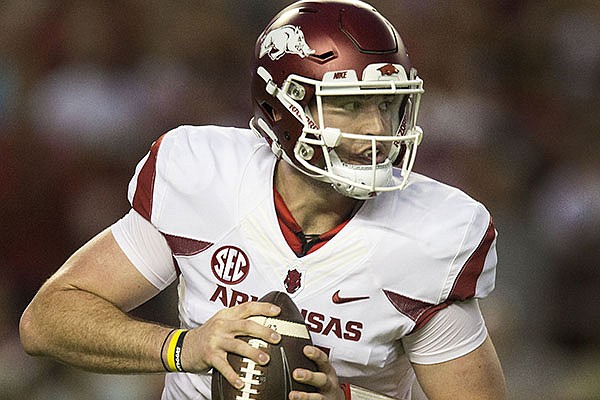LITTLE ROCK — Positive that Arkansas’ starting quarterback is on campus, the plan to rebut the coronation of Gerry Bohanon included citing Gary Brashears’ history.
On Tuesday afternoon, the four-star dual threat from Earle squelched the debate, announcing he would be a Baylor Bear.
Once Chad Morris was hired to replace Bret Bielema as Arkansas’ head coach, folks dismissed Cole Kelley and fawned over Bohanon, somehow discerning from highlights and stats that he was perfect for the new up-tempo spread offense.
A friend familiar with Morris’ offense and Arkansas’ personnel even suggested the 6-foot-7, 268-pound Kelley — the Razorbacks’ only quarterback with starting experience — would be so uncomfortable in the offense that he would transfer.
Teasing the recruiting process, Bohanon posted pictures of himself in the uniforms of Arkansas, Baylor, Memphis and Indiana.
If Bohanon had picked Arkansas, I was prepared to cite Brashears to counter the idea that gaudy numbers compiled vs. small schools in east Arkansas proved Bohanon was a can’t miss.
In the late 1990s, Brashears was likewise identified. Florida State, Miami, Michigan and Tennessee were among the schools pursuing the 6-foot-5, 220-pound quarterback from Clarksville who signed with Arkansas. He completed both of his passes in 1999 and was expected to compete for the starting job the next year, but left Fayetteville in August. A few years later, he played some at Alabama State.
The snapshot of Brashears’ career is meant only as a reminder that there is no sure thing when it comes to a star athlete in high school duplicating his success in college.
Originally, I wondered if Kelley was a round peg and Morris’ offense was the proverbial square hole.
That perception changed after perusing three years of statistics by SMU quarterbacks under Morris and reviewing something he said when introduced as Arkansas’ coach.
The run-pass mix of plays selected for SMU quarterbacks Matt Davis and Brian Hicks indicate Morris will tweak the offense to fit the skills of available players:
—2015, Davis, 187 carries for 761 yards, 336 pass attempts in 12 games. Only once did he have less than 11 carries in a game. A dual threat for sure.
—2016, After Davis was injured, Hicks, 41 carries for minus 83 yards, 422 passes in 11 games. Never did he carry more than six times in a game.
—2017, Hicks, 47 carries for 79 yards, 438 pass attempts in 12 games. Only in the season finale did he have as many as seven carries.
The conclusion is that Morris prefers a run-pass quarterback, but the Mustangs won 11 in two years with Hicks.
Kelley is not going to tuck the ball and go 60 yards against a quality defense, but he is bigger than linebackers and seems to relish running the ball. He was sacked more than a dozen times, but those losses were part of his 43 carries in four starts.
Asked about zone-read plays his first day on the job, Morris offered encouraging insight.
“Sometimes you may not have those mobile quarterbacks, so your zone read may not be as much … pull down and run, it may be a pull down and throw, more of a triple-option effect,” he said.
Kelley can do that.
Among the quarterbacks already enrolled, redshirt Daulton Hyatt comes closest to being a dual threat. During the 2017 season, his athleticism was evident when he emulated the opponent’s quarterback. For what it’s worth, Hyatt threw for 6,216 yards and 50 touchdowns, and rushed for 1,854 yards and 16 TDs in high school.
Other candidates include Ty Storey, who was stuck behind Kelley this season and might have transferred if Bielema and his staff had remained, plus incoming freshman pocket passer Connor Noland and redshirt freshman Jack Lindsey.
Let the competition begin.

